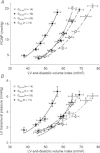Effect of ageing on left ventricular compliance and distensibility in healthy sedentary humans
- PMID: 22331419
- PMCID: PMC3573309
- DOI: 10.1113/jphysiol.2011.218271
Effect of ageing on left ventricular compliance and distensibility in healthy sedentary humans
Abstract
Healthy, but sedentary ageing leads to marked atrophy and stiffening of the heart, with substantially reduced cardiac compliance; but the time course of when this process occurs during normal ageing is unknown. Seventy healthy sedentary subjects (39 female; 21–77 years) were recruited from the Dallas Heart Study, a population-based, random community sample and enriched by a second random sample from employees of Texas Health Resources. Subjects were highly screened for co-morbidities and stratified into four groups according to age: G(21−34): 21–34 years, G(35−49): 35–49 years, G5(0−64): 50–64 years, G(≥65): ≥65 years. All subjects underwent invasive haemodynamic measurements with right heart catheterization to define Starling and left ventricular (LV) pressure–volume curves. LV end-diastolic volumes (EDV) were measured by echocardiography at baseline, −15 and −30 mmHg lower-body negative pressure, and 15 and 30 ml kg(−1) saline infusion with simultaneous measurements of pulmonary capillary wedge pressure. There were no differences in heart rate or blood pressures among the four groups at baseline. Baseline EDV index was smaller in G(≥65) than other groups. LV diastolic pressure–volume curves confirmed a substantially greater LV compliance in G(21−34) compared with G(50−64) and G(≥65), resulting in greater LV volume changes with preload manipulations. Although LV chamber compliance in G(50−64) and G(≥65) appeared identical, pressure–volume curves were shifted leftward, toward a decreased distensibility, with increasing age. These results suggest that LV stiffening in healthy ageing occurs during the transition between youth and middle-age and becomes manifest between the ages of 50 to 64. Thereafter, this LV stiffening is followed by LV volume contraction and remodelling after the age of 65.
Figures




References
-
- Arbab-Zadeh A, Dijk E, Prasad A, Fu Q, Torres P, Zhang R, et al. Effect of aging and physical activity on left ventricular compliance. Circulation. 2004;110:1799–1805. - PubMed
-
- Belenkie I, Kieser TM, Sas R, Smith ER, Tyberg JV. Evidence for left ventricular constraint during open heart surgery. Can J Cardiol. 2002;18:951–959. - PubMed
-
- Chahal NS, Lim TK, Jain P, Chambers JC, Kooner JS, Senior R. Normative reference values for the tissue Doppler imaging parameters of left ventricular function: a population-based study. Eur J Echocardiogr. 2010;11:51–56. - PubMed
-
- Chemla D, Hébert JL, Coirault C, Zamani K, Suard I, Colin P, Lecarpentier Y. Total arterial compliance estimated by stroke volume-to-aortic pulse pressure ratio in humans. Am J Physiol Heart Circ Physiol. 1998;274:H500–H505. - PubMed
Publication types
MeSH terms
Grants and funding
LinkOut - more resources
Full Text Sources
Medical

